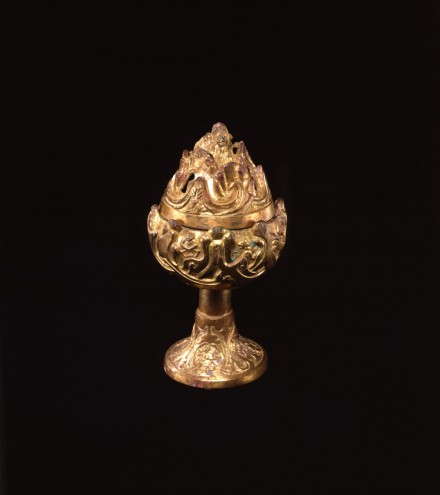J.J. Lally & Co., Oriental Art / New York City, New York
MenuPast Exhibition
Bronze and Gold in Ancient China
March 24 - April 12, 2003

18.
A GILT BRONZE CENSER AND COVER (BOSHANLU)
Western Han Dynasty (206 B.C. - A.D. 8)
the pierced cover elaborately cast in the form of mountain peaks with numerous animals in relief amidst stylized clouds swirling around the crags and cliffs, including a wild boar, a bear, a deer, a hound and two felines; the cover resting on the inset rim of a separately cast bowl with deep sides decorated with a repeating pattern of overlapping stylized cloud bands and with striated peaks rising over the rim, also cast in relief with further animals and figures emerging from the clouds and standing on the cliffs, including another wild boar, a monkey, a tiger, a man on horseback and a man stretching a bow, the bowl raised on a columnar stem rising from a spreading foot of circular outline cast in relief with more animals amidst stylized cloud motifs, the surface richly gilded overall and showing some reddish and bright green patination, the underside of the base with three truncated pegs formerly attached to a dish-form support and with bright green and reddish encrustation from burial.
Height 6 3⁄4 inches (17.2 cm)
It is rare to find gilt bronze boshanlu of this elaborate form. Compare the gilt bronze boshanlu of much simpler design with dish-form support in the collection of the Nanjing Provincial Museum illustrated in Zhongguo Wenwu Jinghua Daquan, Qingtongjuan (Compendium of Chinese Archaeological Treasures, Bronzes), Hong Kong, 1994, no. 1218, p. 339. Another gilt bronze boshanlu, with a coiled dragon around the stem is illustrated in Ancient Chinese Arts in the Idemitsu Collection, Tokyo, 1989, no. 206. Compare also the bronze boshanlu of similar form excavated from a Western Han tomb in Shouxian, Shanxi province and illustrated in Wenwu, 1987, No. 6, p. 27, fig. 55:6.
The term boshanlu which may be translated as “bo mountain censer”, can be traced back to the 4th century or earlier, but no particular Bo mountain can be identified in Chinese literature or geography, and the specific origins of the term remain a mystery. One traditional Chinese explanation is that the censer represents Mount Hua. It is said that the King Chao of Qin challenged the heavenly spirits to a game of liubo (a board game similar to chess) on Mount Hua, and so in honor of this event, the mountain was given the name of (Liu) Bo Mountain (bo shan). Berthold Laufer suggested that the mountain represents Penglai, the magical realm of the Daoist Immortals. It has also been suggested that the mountain represents Kunlun, the cosmic mountain of China which was said to exist in a range of mystical mountains northwest of the Chinese frontier. The boshanlu type of censer gained wide popularity during the Western Han, and a wide variety of different interpretations of the form in bronze and pottery have been recorded.
18.
A GILT BRONZE CENSER AND COVER (BOSHANLU)
Western Han Dynasty (206 B.C. - A.D. 8)
Height 6 3⁄4 inches (17.2 cm)